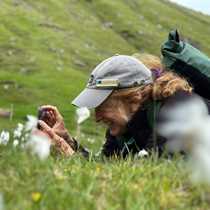From below we had a different perspective. American avocets waded and fed in the muddy shallows created by the backwaters from Lower Monumental Dam. Our Zodiac tours quietly observed these colorful birds in full breeding plumage as we entered the Palouse River Canyon and marveled at the impressive grandeur around us. Birds of prey, cliff swallows building mud nests, mule deer, a coyote, and chokecherries laden with clusters of white flowers were all additional components of the landscape today.
Millions of years ago, massive amounts of very fluid lava erupted through fissures in the earth's crust to form the Columbia Plateau. During the last ice age, huge floods poured out of a large glacial lake formed by an ice dam from the continental ice sheet. These immense floods repeatedly scoured the landscape, scraping off topsoil, carving channels, and deepening and widening the Columbia Valley. Huge gravel bars were deposited throughout the course of the floodwaters. The catastrophic geologic events which created the features along the river are part of the awesome fascination that makes our expedition so interesting. One must wonder what the members of the Lewis and Clark party thought and felt as they made their remarkable exploratory journey through this same territory almost 200 years ago.




